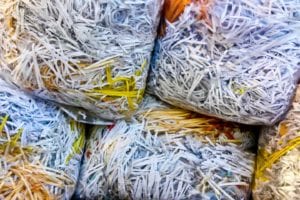Millions of tonnes of waste are generate each year in South Africa. A considerable amount of this is in the form of plastic (polyethylene) shopping bags, most of which are non-degradable and destined for landfill. But, can this inevitable modern waste and environmental hazard find a new application in civil engineering projects such as in road bases, embankments and structure foundations? For over half a century, the world has become increasingly dependent on the use of plastic bags as a packaging material for nearly every product bought.
Highly convenient, strong and inexpensive, plastic bags are appealing to both customers and businesses as a reliable way to deliver goods from the store to home. Unfortunately, since plastic bags were first introduced in the 1950s, they have become a global scourge, littering roadsides, clogging sewers and filling landfills. The durability of these bags is one of the best advantages of its design for humans but is also its greatest weakness since they severely pollute the environment. Although these types of bags have long design lives, they are normally used once before consumers dump them in the bin. In recent years, there has been much effort put into identifying inexpensive and easily accessible reinforcing materials in the geotechnical field (Floss, 1985; Mandal, 1987; Sarsby, 2007). Waste materials are currently being recognised as a potential source of soil reinforcement. For instance, the use of old tyres to increase the bearing capacity and shearing strength of a soil has been studied (Hataf and Rahimi, 2006). However, despite the large quantity of plastic bags produced, there is hardly any reported work on turning polyethylene bags into a civil engineering resource. This project was, therefore, undertaken to investigate whether such plastic bags were capable of increasing soil strength and consequently could be incorporated in projects such as those requiring strengthening of foundations and embankments. The study was not intended to prove this type of reinforcement to be better than established methods like geosynthetic reinforcement. Those conventional methods, however, are expensive and inaccessible to the majority of developing countries. Plastic bags, in contrast, are cheap and abundant as a waste material. Finding a new application for them in the civil engineering works could cut down the waste that goes into landfill sites.Research materials and methods Plastic bag material
The plastic materials used in the study were grocery shopping bags sourced from the local supermarket. The bags were medium sized and manufactured from high-density polyethylene by a South African company based in Johannesburg. The bags were light green in colour with black print on either side, as displayed in Figure 1. The material density was measured to average 798 kg/m3. While the tensile strength, determined using a computer controlled Zwick universal material testing machine, ranged between 14 and 20 MPa. The thickness of the bags was 20 µm. Selected soil material
Cape Flats sand and Klipheuwel sand were specifically selected because of their availability locally. Additionally, these two sand types are clean, consistent and easily controllable i.e. identical samples could be reproduced if prepared the same way thereby enhancing repeatability of results. Cape Flats sand is a medium-dense, light grey, clean quartz sand. Klipheuwel sand is a uniformly graded medium-dense, reddish brown sand. Table 1 summarises the mechanical properties of the two soils determined according to BS 1377: 1990. Methodology
All tests were conducted with dry soil in order to eliminate any effect of water during investigation. In each experiment, the soil specimen was first spread out over a pan and oven dried at 105 0C for 24 hours. The grocery bags were cut into strips of 5 distinct rectangular dimensions using a guillotine (Figure 2). This allowed for the investigation of the optimum length, width and concentration of the plastic reinforcements required to obtain the maximum soil strength characteristics of the composite material. The 5 reinforcement strips dimensions used were; 6 x 15 mm, 6 x 30 mm, 6 x 45 mm, 12 x 15 mm and 18 x 15 mm. The elements dimensions chosen were in the range of 0.06 – 0.45 of the shear box dimensions so as to control entanglement between the reinforcing strips. Strips entanglement would limit soil particles forming surface attachments with the reinforcement resulting into lower shearing strengths of the composite material. For any given test, a batch of plastic strips of known dimensions and weight was added to a predetermined dry soil weight and then thoroughly and randomly mixed in a plastic bowl using a spatula to form a composite material with the required reinforcement content (Figure 3). The three reinforcement concentrations used were: 0.1, 0.2 and 0.3% by mass. These relatively low concentrations were chosen because, although the strips are light in weight, they occupy large volumes. Additionally, at the selected concentrations, it was easier to ensure consistency and even distribution of reinforcing elements within the soil sample without entanglement between strips
Once the each specimen had been thoroughly mixed, it was poured into the already assembled shear box in three layers compacting each with a square wooden tamper. The shear strength of the composite material was then determined using a 100mm square Wykeham Farrance SB1 constant rate of strain direct shear apparatus, at normal stresses of 25, 50 and 100 kPa and a shear speed of 1.2 mm/min until a residual state was achieved.
>> Test results and discussionThe peak shear stress from each composite sample was recorded for the applied normal stresses of 25, 50 and 100 kPa. These values were then plotted against normal stress to determine the friction angles for each composite material tested. The relationship between the friction angle and the reinforcement parameters were plotted as shown in Figures 5 to 7. Details of all the results from this study were presented by Petersen (2009). This section only gives a summary. Effect of length
It is apparent from Figure 5 that addition of high-density polyethylene strips of any length enhances the peak friction angle for both Cape Flats and Klipheuwel sands. For instance, after the inclusion of the 6 x 15 mm strips, the Cape Flats sand friction angle increased from about 34 to 41. In terms of shearing resistance (i.e. tan phi), this was an improvement of 28.3% compared to the unreinforced soil. Klipheuwel sand experienced a shearing resistance angle increase from 39 to 44 when similar element sizes were used. This was a 19.1% enhancement in shearing strength (in tan phi). The maximum soil friction angles obtained in the composites were found to be greater in the Klipheuwel specimens. This was due to the higher initial shear strength in that better graded sand.
Figures 5(a) and 5(b) illustrate the effect of lengthening the reinforcement while keeping the width constant at 6 mm. A non-linear relationship was generally observed with each sandy soil exhibiting a unique characteristic response. In the Cape Flats, the soil shear strength improved with increased strip length over specified lengths of 15 and 45 mm, dropping when strips 30 mm long were used. It is likely that this point could have been an anomaly in that test. The laboratory results also displayed that when the fibre length was increased in the Klipheuwel sand, the soil friction angle also became better peaking with the 15 mm long strip elements (shortest strips tested). Therefore, it is likely that there are limiting plastic strip lengths in the soil composites beyond which reinforcement lengthening results in decreases in the shear strength. Effect of width
Analysis of Figures 6(a) and 6(b) showing the effect of reinforcement width on composite peak friction angle, demonstrate that the inclusion of plastic strips significantly raises the peak shear strength. Further testing revealed that beyond a specific reinforcement width of 6 mm (narrowest strip tested), the strength decreased. It is possible that more testing could have revealed that the greatest strength gain occurs for strips narrower than 6mm. These results suggest that the gains in strength decrease as the reinforcement strips widen. The plastic material used in this study being smooth, it is likely that when longer and wider strips are used, they overlap each other more during shearing thereby reducing the soil/reinforcement interaction. As expected, there would be less friction generated between strips than between soil and embedded strips. It was again observed that Klipheuwel composites generally had higher peak friction angles.
Effect of concentration
From Figure 7(a), there was an observed jump from the initial friction angle of 33.9 in the Cape Flats sand, to 41.7 for the 0.1% concentration composite, after which there was an almost linear increase in the friction angle with concentration. The pattern in Klipheuwel composites was however different. In Klipheuwel, the reinforcement concentration considerably increased the peak friction angle initially. However; further testing revealed that beyond the reinforcement concentration of 0.15 the strength decreased. It can be concluded that for various soils, with different grading, independent tests would need to be conducted to determine the individual soil strength enhancement performances. The laboratory experiments also favourably suggest that inclusion of polyethylene strips in sandy soils would be an effective soil reinforcement method.
Deformation of reinforcement elements
At the end of each direct shear experiment, the state of the reinforcement elements was assessed. The assessment looked for the presence of dents and any other physical deformations like rupture in each element. It also compared the nature of the deformations with the location of the element with regards to the shearing plane. Through visual inspections it was found that approximately 70% of the elements which deformed were within or close to the shearing zone. Some strips were primarily ‘indented’ as soil particles pressed in to form surface attachments with the reinforcements (Figure 8(a)). Others were stretched and compressed due to the shearing action at or near the shear plane (Figure 8(b)). The stretched elements were found to be located somewhat parallel to the shearing direction, and therefore got deformed accordingly. This proved that as the embedded elements were being strained relative to the shearing direction, they improved the soil tensile strength thereby enabling additional transfer of forces arising during the loading conditions. Furthermore, it was noted that none of the reinforcements in the composite were severely indented or ruptured during the shearing operation. Summary and conclusions
In this work, the improvement of soil strength using plastic grocery bags made from high-density polyethylene was studied. A comprehensive test programme was undertaken including direct shear tests on two selected sandy soils. Plastic strips were used as reinforcement inclusions at concentrations of up to 0.3% by weight. The effect of the dimensions of the strip was investigated by varying the length of the strips from 15 to 45 mm and the width from 6 to 18 mm. Shear strength parameters were obtained for each composite material from which analyses were done to identify the extent of the soil improvement.
The results showed an increase of more than 20% increase in angle of internal friction, which would consequently result in significant increases in shear strength and soil bearing capacity. The addition of the strips improved the shear strength but lengthening and widening the strips reduced the improvement. These results further suggest that the use of this type of reinforcement may prove beneficial with embankments and other foundation/geotechnical works. The results are, however, specific to the particular type of plastic shopping bag used and the soil with which the reinforcement was mixed. Testing in a range of soil types with inclusion of plastics from different sources, thickness and roughness is required in order to properly document behaviour. The use of plastic shopping bag wastes as a reinforcement material could provide an alternative to waste accumulation and an economic means of resource recovery.








